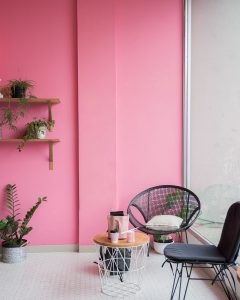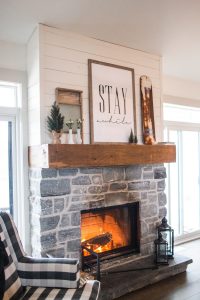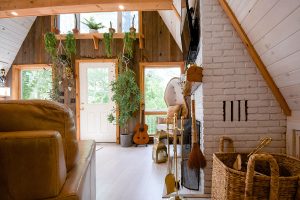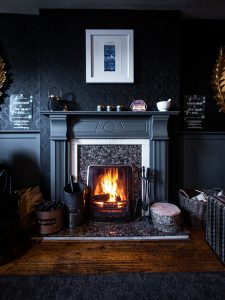Lifescape
By Janet Armstrong,
Certified Interior Designer, CAPS
Let the design and architecture be your guide
 I am often asked by clients if feature walls are still au courant. While the concept and style of a feature wall may have changed over time, their use is still an appropriate element in home design and decor. Typically, a feature wall is used in one of two situations — either to highlight or to downplay. If you have a particular architectural feature or focal point you would like to highlight, a feature wall is an ideal approach to ensure the feature is the focal point of the space. Conversely, if there is something not particularly attractive in a space that you d not want to draw attention to such as a structural element, flooring, unattractive fireplace or less than-ideal view, you can downplay it. Consider too that feature walls are perfect for an open concept home, where they can serve to create definition to the functional areas.
I am often asked by clients if feature walls are still au courant. While the concept and style of a feature wall may have changed over time, their use is still an appropriate element in home design and decor. Typically, a feature wall is used in one of two situations — either to highlight or to downplay. If you have a particular architectural feature or focal point you would like to highlight, a feature wall is an ideal approach to ensure the feature is the focal point of the space. Conversely, if there is something not particularly attractive in a space that you d not want to draw attention to such as a structural element, flooring, unattractive fireplace or less than-ideal view, you can downplay it. Consider too that feature walls are perfect for an open concept home, where they can serve to create definition to the functional areas.
Paint is one of the easiest and most economical ways to downplay a feature. Lighter colours recede, so paint the feature you are trying to minimize and all surrounding walls the same lighter colour to not only downplay the less-than-ideal feature but bring cohesiveness to the space. To highlight a feature, select dark paint colours to draw the feature forward, so the eye naturally moves to what you are highlighting; paint the other walls a lighter coordinating colour to allow the feature to stand out. If you want to create a feature wall that highlights, paint is not the only way to achieve that, and you could consider some of the following materials that create a stunning focal point in your space.
Brick
 Brick adds texture and depth to any space and the use of natural stone grounds your room. Interior brick, also sometimes referred to as think brick, half brick or faux brick, is available as individual bricks but also comes in panels. The colour selection is extensive, ranging from plain white to vintage and weathered red, red and black, terracotta, fossil clay and grays. With this wide range available, finding the perfect brick to augment the style of your space will be effortless.
Brick adds texture and depth to any space and the use of natural stone grounds your room. Interior brick, also sometimes referred to as think brick, half brick or faux brick, is available as individual bricks but also comes in panels. The colour selection is extensive, ranging from plain white to vintage and weathered red, red and black, terracotta, fossil clay and grays. With this wide range available, finding the perfect brick to augment the style of your space will be effortless.
Stone
Another option is ledger brick, also known as ledge stone, ledger stone, stacked stone or stone veneer that has the appearance of stacked stone. This product is formed of rectangular strips of varying lengths and/or widths arranged on a mesh backing. Available in natural stone, travertine, slate and quartzite, this product adds warmth, depth and texture and enhances any traditional or contemporary decor and design style.
Tile
Tile options are almost limitless, considering there are not only colour choices but patterns, textures, sizes, shapes, finishes and installation orientation choices. The most common places we see tile used is as a backsplash, tub and shower walls and around fireplaces. However, tile walls are now appearing outside of these applications and creating stunning focal points in residential spaces. If your space is small, do not discount this option — glass tiles add dimension, and the reflection makes a small room look more spacious.
Wood Plank
 Wood adds warmth to any space and a wooden feature wall will add warmth as well as texture and depth. There are a number of options to consider from horizontal, vertical, or a patterned (for example, herringbone or chevron) installation, wide, narrow or tongue in groove board or raised panel (also known as a shaker panel) wall. The additional advantage of a wooden feature wall is that it can be adapted to and complement a wide range of decor and design styles.
Wood adds warmth to any space and a wooden feature wall will add warmth as well as texture and depth. There are a number of options to consider from horizontal, vertical, or a patterned (for example, herringbone or chevron) installation, wide, narrow or tongue in groove board or raised panel (also known as a shaker panel) wall. The additional advantage of a wooden feature wall is that it can be adapted to and complement a wide range of decor and design styles.
Wallpaper
 Before you panic, let me assure you that wallpaper has come a long way. Gone are the days of applying wallpaper paste or pre-pasted wallpapers and the frustration that comes with them. Wallpapers today are largely of the peel and stick variety that are easily removed when you want to update the room. Wall decals are another popular option and available in a wide range of sizes and patterns and can work beautifully to highlight a feature wall. If you aren’t sure if a feature wall is right for your space, take guidance from the room’s design and architecture — is there a place your eye naturally moves to and rests on? If your space is small, a feature wall would not be advantageous as it would make the room feel smaller and perhaps chaotic and crowded. If your space is suited to a feature wall, the options outlined above will help you select a material that will provide a visually stunning focal point that will enhance the ambience of the room.
Before you panic, let me assure you that wallpaper has come a long way. Gone are the days of applying wallpaper paste or pre-pasted wallpapers and the frustration that comes with them. Wallpapers today are largely of the peel and stick variety that are easily removed when you want to update the room. Wall decals are another popular option and available in a wide range of sizes and patterns and can work beautifully to highlight a feature wall. If you aren’t sure if a feature wall is right for your space, take guidance from the room’s design and architecture — is there a place your eye naturally moves to and rests on? If your space is small, a feature wall would not be advantageous as it would make the room feel smaller and perhaps chaotic and crowded. If your space is suited to a feature wall, the options outlined above will help you select a material that will provide a visually stunning focal point that will enhance the ambience of the room.
Janet Armstrong (simplyswankdecor.ca) is a graduate of the Interior Design Institute of Canada, CAPS (Certified Aging in Place Specialist) and Chair of the Decorators and Designers Association of Canada (DDA Canada).






